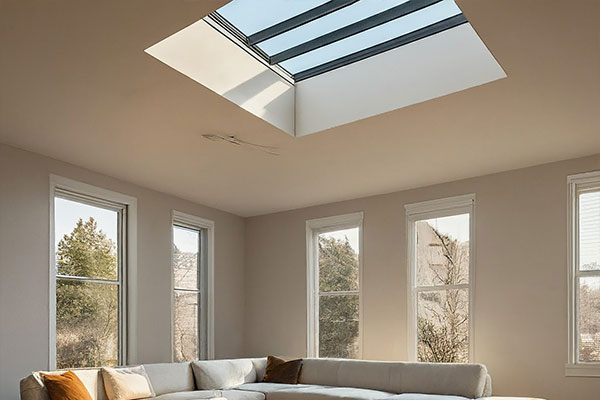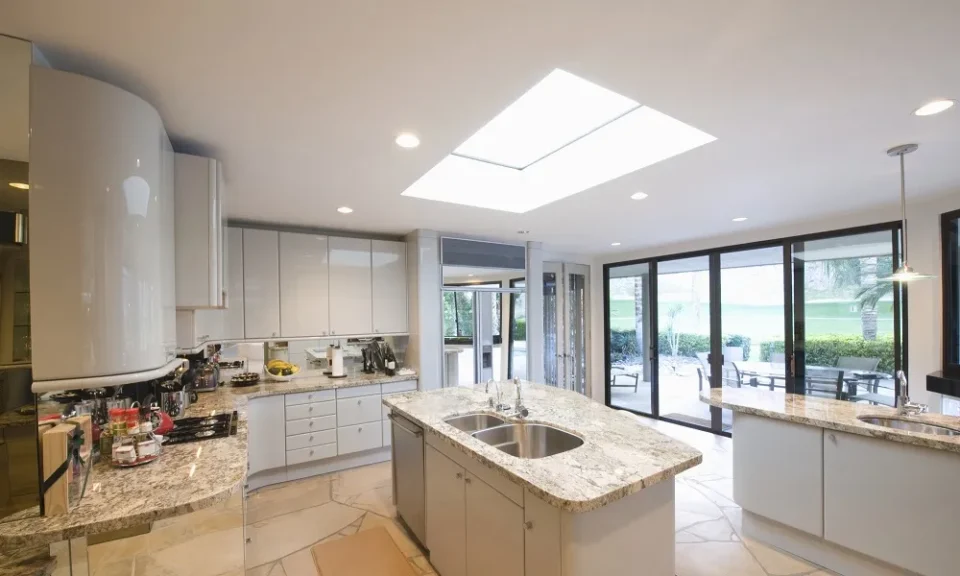Skylights play a significant role in regulating indoor temperature by allowing natural sunlight to enter a space while also impacting heat retention and dissipation. During the winter months, strategically placed skylights can introduce warmth by capturing solar heat, reducing the need for artificial heating. Conversely, in the summer, poorly positioned skylights may contribute to excessive heat gain, making cooling systems work harder to maintain a comfortable environment.
The thermal dynamics of skylights depend on factors such as glass type, positioning, and seasonal sun angles. Heat gain occurs when sunlight penetrates the glass and warms the air inside, while heat loss happens when warm indoor air escapes through the skylight’s surface. Proper insulation, glazing choices, and the use of reflective coatings can mitigate unwanted temperature fluctuations, ensuring a balanced indoor climate.
Optimizing skylight placement can significantly improve energy efficiency by reducing reliance on heating and cooling systems. Positioning skylights in areas where they maximize natural daylight while minimizing heat loss helps homeowners maintain comfortable indoor temperatures without excessive energy consumption. A well-placed skylight can illuminate an entire room, cutting down on the need for artificial lighting while improving thermal efficiency.
Choosing the Best Skylight Position for Different Climates
Factors such as sun exposure, ventilation, and seasonal weather patterns must all be considered to maximize the benefits of skylights. Understanding how these elements interact with skylight positioning allows homeowners to make informed decisions that enhance both functionality and aesthetic appeal.
- Skylights in Cold Climates. In colder regions, skylights should be positioned to capture as much sunlight as possible during the day. South-facing skylights are particularly effective at increasing warmth by absorbing direct sunlight, while double or triple-glazed glass reduces heat loss during frigid nights. Incorporating insulated shades can further optimize heat retention when the sun goes down.
- Skylights in Warm Climates. For homes in warmer regions, skylights should be placed in locations that minimize excessive heat gain. North-facing skylights provide consistent, indirect natural light without the intensity of direct sun exposure. Installing vented skylights can also help release trapped heat, enhancing indoor comfort without overburdening air conditioning systems.
- Humid vs. Dry Regions. Humidity levels influence how skylights affect indoor climates. In humid environments, ventilation is key—operable skylights allow moisture buildup to escape, preventing mold growth and excessive condensation. In contrast, dry regions benefit from skylights that maximize daylight exposure while incorporating shading solutions to reduce heat gain.
- Seasonal Sun Path. The sun’s position shifts throughout the year, impacting how skylights interact with natural light and temperature control. Understanding seasonal sun paths allows homeowners to optimize skylight positioning for year-round comfort. Adjustable blinds, tinting solutions, and smart glazing can further regulate heat gain and loss as seasons change.
Skylight Orientation: The Impact of Direction on Comfort
The direction a skylight faces can significantly influence a home’s energy efficiency and comfort. Proper skylight orientation determines how much natural light and heat enter a space, affecting everything from indoor temperature control to overall ambiance. Understanding the strengths and challenges of each directional placement allows homeowners to maximize natural light while minimizing unwanted heat gain or loss. Whether it’s a north-facing skylight that offers stable illumination or a west-facing one that requires heat-mitigation strategies, selecting the right orientation can enhance both functionality and aesthetic appeal.
- North-Facing Skylights. North-facing skylights provide a steady source of indirect sunlight throughout the day. This orientation minimizes heat gain while ensuring rooms receive ample natural light, making it an ideal choice for workspaces and kitchens where balanced illumination is desired.
- South-Facing Skylights. South-facing skylights are advantageous in colder climates, capturing the sun’s warmth during the day and reducing heating costs. However, without proper shading solutions, they can contribute to overheating in the summer, requiring adjustable coverings or coatings to maintain comfort.
- East-Facing Skylights. Skylights positioned on the eastern side of a home welcome soft morning sunlight, creating a bright and refreshing atmosphere without excessive heat buildup. This positioning is beneficial in bedrooms and dining areas where natural light enhances ambiance without compromising temperature control.
- West-Facing Skylights. West-facing skylights capture the intense afternoon sun, which can significantly increase indoor temperatures. To counteract this, homeowners should consider using heat-reflective glass, exterior shading, or ventilated skylights to regulate indoor climate and maintain cooling efficiency.

How to Prevent Skylight Glare and Heat Buildup
Glare and excessive heat from skylights can make a space uncomfortable, particularly in warmer months or when skylights are not strategically placed. Choosing the right type of glazing, such as Low-E or tinted glass, helps reduce solar heat gain while allowing natural light to filter in. Additionally, installing skylight blinds or motorized shades offers homeowners control over light levels throughout the day.
Ventilated skylights can also mitigate heat buildup by allowing warm air to escape, improving airflow and indoor temperature balance. Proper placement is crucial—north-facing skylights tend to provide consistent light without excessive heat, while south- and west-facing skylights may require external shading solutions like awnings or solar-reflective films.
Another effective strategy is the use of skylight diffusers, which soften harsh light and reduce direct glare, enhancing overall comfort. Combining these solutions with well-planned interior ventilation ensures that skylights contribute to a well-lit, energy-efficient, and temperature-regulated home.
Energy-Saving Skylight Installation Tips
Installing skylights with energy efficiency in mind can significantly impact heating and cooling costs. Thoughtful installation techniques, material selection, and positioning help reduce heat loss in winter and prevent excessive heat gain in summer. Investing in energy-efficient skylight solutions, such as low-emissivity (Low-E) coatings, double or triple glazing, and thermal-insulated frames, enhances overall performance and minimizes energy waste.
Proper sealing and flashing around the skylight prevent air leaks and water infiltration, which are common issues that compromise insulation. Integrating skylights with smart climate control systems, such as automated blinds or sensors that adjust based on outdoor conditions, can further improve energy savings. Additionally, homeowners should consider solar-powered or vented skylights to enhance ventilation and reduce reliance on mechanical cooling systems.
By working with professionals to determine optimal placement and utilizing advanced glazing technologies, skylight installations can enhance indoor comfort while contributing to long-term energy efficiency
Choosing the Right Skylight Position for Maximum Daylight Without Temperature Swings
The placement of a skylight is one of the most crucial factors in ensuring both optimal daylight and energy efficiency. Skylights that are incorrectly positioned may lead to excessive heat gain in summer or significant heat loss in winter, making temperature regulation a challenge. Properly placed skylights can maximize natural light exposure while minimizing unwanted thermal fluctuations, creating a comfortable indoor environment year-round.
Factors such as the building’s orientation, roof pitch, and climate conditions must be considered when determining the best skylight placement. North-facing skylights offer consistent, indirect light without overheating a space, while south-facing skylights can be beneficial in colder climates for passive solar heating. East-facing skylights provide warm morning light, while west-facing skylights should be strategically shaded to avoid afternoon overheating. Combining thoughtful skylight positioning with energy-efficient glazing and shading solutions ensures an ideal balance between natural illumination and indoor comfort.

